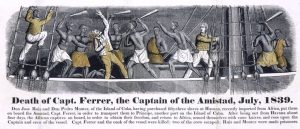
Glenda Francisco
Eng 302
Professor Kappes
March 24, 2018
“The Interesting Narrative of the Life of Olaudah Equiano” is an autobiography written by Olaudah Equiano, himself. It describes his life as a slave. Equiano was born in 1745 in Eboe, which is now Nigeria. Eboe had a structured system, that included law and marriage. Its inhabitants had manners and were humble, although, there was not much wealth. Equiano describes his life as the youngest son of seven brothers and sisters. He was trained in agriculture and war. One day Equiano and his sister were left alone at home and he was in charge of looking after his family’s premises while his parents went to work. Although it was a custom and it was assumed that they would be safe, Equiano was kidnapped along with his sister and he was sold into slavery at age 11. They were separated and sold individually. Yet, they met once again through a change of ownership, but separated once again.When he was sold to his first owner, Equiano tried to escape, but failed. After being sold a couple of more times, Equiano recalls being captive and aboard a ship where he saw many black people chained together with expressions of profound sorrow. He viewed the white men as cruel evil spirits similarly to the image, “Death of Capt. Ferrer, the Captain of the Amistad, July, 1839.”
In the image, the slaves are seen wearing “little to nothing” clothing compared to their counterparts who are fully clothed. The illustrator depicts a vivid picture of the fear, violence, misfortune, and yet the strength, determination and courage of slaves. They fear the continuation of cruel treatment and the impending beatings. They fear the life they are forced to live. Equiano shows the same feelings throughout his narrative as time and time again he is sold to a new owner. At the end, Equiano “worked” hard to gain his liberty. In 1766, he purchased his own freedom “through a process called redemption rather than escape (p.9).” The slaves on the ship, however, “fought” for their freedom and used a more aggressive approach. The slaves may have not had the same luck as Equiano, whose last owner showed more respect for him than most. Equiano wanted to help other “blacks” through better means. To arm themselves with knives and kill their captain, the slaves on the ship showed desperation and hopes for a better future, but felt that violence was the best way to obtain their freedom. The image does not go into detail about what happened to the slaves afterward except that they wished to go back to their native land in Africa. On the other hand, Equiano’s drive and ultimate goal was to abolish the African slave trade.
Aquiano is also known as Gustavus Vassa, a name given to him by his owner. In the article, “The Life of Gustavus Vassa,” Gustavus emphasizes his experience of abduction when he states, “These filled me with astonishment, which was soon converted into terror, which I am yet at a loss to describe, nor the then feelings of my mind (page. 55).” Gustavus describes the feeling of terror he encountered while being kidnapped and taken to the sea coast. Like any slave, he was physically and mentally abused by his owners. Slaves were treated badly without a chance to fend for themselves. Gustavus felt his life threatened by how he was being handled because this time around his owner was different and the language was unfamiliar.
I believe these articles and the image can evoke many different emotions and may have evoked these same emotions during that time period. Based on both the article and image, slave owners owned slaves as part of property. However, slaves worked hard, underwent many obstacles, and remained strong. Equiano and the slaves were removed from their homes and from everything they knew. Although their journey’s were different, it was clear Equiano and the slaves despised slavery and wished for it to end.
Work Cited Page
- The New York Public Library’s The Schomburg Center for Research in Black Culture: “In Motion: The African American Migration Experience”:
http://www.inmotionaame.org/gallery/?migration=1&topic=99&type=image

